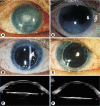Black diaphragm intraocular lens implantation and penetrating keratoplasty in aphakic eyes with traumatic aniridia
- PMID: 23638421
- PMCID: PMC3633758
- DOI: 10.3980/j.issn.2222-3959.2013.02.15
Black diaphragm intraocular lens implantation and penetrating keratoplasty in aphakic eyes with traumatic aniridia
Abstract
Aim: To evaluate the long-term outcome of implantation of black diaphragm intraocular (BDI) lens combined with penetrating keratoplasty (PKP) for managing aphakic eyes with traumatic aniridia and corneal damage.
Methods: Six aphakic eyes of six patients with traumatic aniridia and corneal damage had BDI lens implantation at Qingdao Eye Hospital, Shandong Eye Institute from June 2008 to November 2011. Medical records of the patients were reviewed. Three patients received PKP and after 12-18months were implanted with BDI lens. The other three patients completed PKP and BDI lens implantation at the same time. The corrected visual acuity, intraocular pressure and number of corneal endothelial cells were monitored.
Results: The patients were followed up for an average of 24.3±12.1months (range 14-48 months). All BDI lenses were located well. The best corrected visual acuity got improved in 5 patients (0.1-1.0) and decreased in 1 patient from 0.4 to 0.2. Three patients had normal intraocular pressure (IOP) after implantation. Two patients required antiglaucoma medications to control IOP within the normal range and 1 patient implanted Ahmed glaucoma valve to control IOP. The corneal grafts kept transparent in all eyes and the corneal endothelial counting >1 000/mm(2), although two patients experienced acute graft rejection and loss more than 30% corneal endothelial cells.
Conclusion: Implantation of BDI lens combined with PKP is an effective option for managing aphakic eyes with traumatic aniridia and corneal damage. Although the results in our study are encouraging, additional studies of the long-term safety and efficacy are required. A larger study population and longer follow-up may be beneficial.
Keywords: aniridia; black diaphragm intraocular lens; penetrating keratoplasty; trauma.
Figures

Similar articles
-
Black diaphragm intraocular lens implantation in aphakic eyes with traumatic aniridia and previous pars plana vitrectomy.J Cataract Refract Surg. 2003 Nov;29(11):2168-73. doi: 10.1016/s0886-3350(03)00668-0. J Cataract Refract Surg. 2003. PMID: 14670427
-
Long-term efficacy and complications of black diaphragm intraocular lens implantation in patients with traumatic aniridia.Br J Ophthalmol. 2015 May;99(5):659-64. doi: 10.1136/bjophthalmol-2014-305581. Epub 2014 Nov 4. Br J Ophthalmol. 2015. PMID: 25370083
-
The efficacy and complications of black diaphragm intra-ocular lens implantation in patients with congenital aniridia.Acta Ophthalmol. 2016 Aug;94(5):e340-4. doi: 10.1111/aos.12923. Epub 2015 Dec 9. Acta Ophthalmol. 2016. PMID: 26648453
-
Black Diaphragm Intraocular Lens Implantation in Patients with Aniridia.J Ophthalmic Vis Res. 2019 Jan-Mar;14(1):27-31. doi: 10.4103/jovr.jovr_244_17. J Ophthalmic Vis Res. 2019. PMID: 30820283 Free PMC article.
-
Crystalline lens alterations in congenital aniridia.Arch Soc Esp Oftalmol (Engl Ed). 2021 Nov;96 Suppl 1:38-51. doi: 10.1016/j.oftale.2020.12.008. Epub 2021 Jun 12. Arch Soc Esp Oftalmol (Engl Ed). 2021. PMID: 34836587 Review.
Cited by
-
Pars plana vitrectomy combined with penetrating keratoplasty and transscleral-sutured intraocular lens implantation in complex eyes: a case series.BMC Ophthalmol. 2020 Sep 14;20(1):369. doi: 10.1186/s12886-020-01639-y. BMC Ophthalmol. 2020. PMID: 32928189 Free PMC article.
-
The challenging management of pediatric corneal transplantation: an overview of surgical and clinical experiences.Jpn J Ophthalmol. 2017 May;61(3):207-217. doi: 10.1007/s10384-017-0510-4. Epub 2017 Apr 3. Jpn J Ophthalmol. 2017. PMID: 28374268 Review.
-
Surgical correction of corneal opacity and aniridia with penetrating keratoplasty and a new iris prosthesis implant.Graefes Arch Clin Exp Ophthalmol. 2023 May;261(5):1331-1338. doi: 10.1007/s00417-022-05920-2. Epub 2022 Dec 8. Graefes Arch Clin Exp Ophthalmol. 2023. PMID: 36480049
References
-
- Sundmacher R, Reinhard T, Althaus C. Black-diaphragm intraocular lens for correction of aniridia. Ophthalmic Surg. 1994;25(3):180–185. - PubMed
-
- Thompson CG, Fawzy K, Bryce IG, Noble BA. Implantation of a black diaphragm intraocular lens for traumatic aniridia. J Cataract Refract Surg. 1999;25(6):808–813. - PubMed
-
- Beltrame G, Salvetat ML, Chizzolini M, Driussi GB, Busatto P, Di Giorgio G, Barosco F, Scuderi B. Implantation of a black diaphragm intraocular lens in ten cases of post-traumatic aniridia. Eur J Ophthalmol. 2003;13(1):62–68. - PubMed
-
- Chen YJ, Wu PC. Favorable outcome using a black diaphragm intraocular lens for traumatic aniridia with total iridectomy. J Cataract Refract Surg. 2003;29(12):2455–2457. - PubMed
-
- Dong X, Yu B, Xie L. Black diaphragm intraocular lens implantation in aphakic eyes with traumatic aniridia and previous pars plana vitrectomy. J Cataract Refract Surg. 2003;29(11):2168–2173. - PubMed
LinkOut - more resources
Full Text Sources
